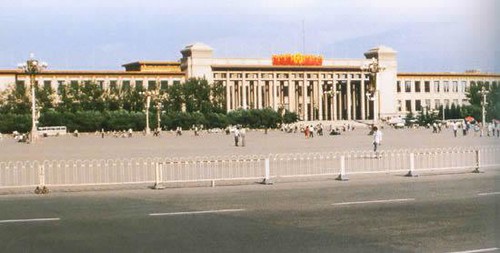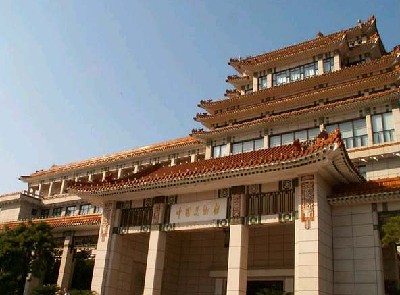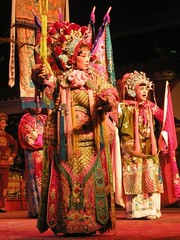| Home > Living in China > Art |
A Brief Look at China National Museum
 |
|
Main gate of China National Museum |
National Museum of China is located on the east side of Tian'an Men Square in Beijing. It is the biggest comprehensive history museum in China. Through display of both material and non-material collections and exhibits, it elaborates the history created by Chinese ancestors.
The National Museum is built on the twin foundations of the former China History Museum and the former China Revolutionary Museum in 2003. The new museum is currently under expansion. It has extremely rich collections and the excellence of its exhibits and depth of its research are second to none.
China Ancient History Section
The National Museum keeps the country's most important historical objects. Through China's History Exhibition, these are shown to visitors from both inside and outside China, to display the long history and shining civilization of the Chinese people. At the same time, the museum undertakes education projects, archaeological excavations and scientific research.
The earliest items on display here are the teeth of Yuanmou Man from Yunnan Province, dating back some 1,700,000 years. The most recent are historical artifacts from Xinhai Revolution of 1911.
The Early Society Exhibition starts with ancient inhabitants (around 1,700,000 years ago to 10,000 years ago), then clan society (around 10,000 years ago to 5,000 years ago) and the dawn of civilization (around 5000 to 4000 years ago). In :he ancient inhabitants' section you can see China's earliest 'sapiens' called Yuanmou Man, the slightly later Lantian Man, Beijing Man, Jinniushan Man, and also Shandingdong Man. The last had already entered the homo sapiens period. These ancestors wrote the first page in the chapter of China's history. Stone tools that they created, the seeds they collected, bones of the animals that they hunted are all documented in the exhibition cases. The bone-made needle and the teeth and shells that the Shandingdong Man used for jewelry indicate that by his time, mankind had already begun to sew clothing and have an awareness of aesthetics.
From around 10,000 years ago, mankind began to polish stone tools, make ceramics, weave cloth, and engage in other handicrafts production. The distribution of clans also began to be more widespread. In the exhibit, rice kernels from some 5,000 years ago, bone implements of some 7,000 years ago, and the model of a matriarchal village unearthed in Shaanxi Province from some 6,000 years ago can be seen. From around 5,000 years ago, agricultural techniques were well advanced and besides being able to provide for his own basic needs, man was able to produce a certain surplus. This led to a system of private ownership and the development of classes. At this time, special handicraft industries appeared, also the rudiments of writing, cultural arts and religion. In the exhibits, one can see important ritual implements of the period made from stone and jade.
The slave society was mankind's first class society in history. This period is divided in the exhibition into Xia, Shang, Western Zhou, and Spring and Autumn periods and one that covers all tribes from Xia to Spring and Autumn.
The Xia Dynasty was the first kingdom in Chinese history. Its center of ruling power was the northern part of what is today Henan and the southern part of Shanxi provinces. The Bronze jue excavated from Yanshi in Henan, and the ceramic cup and so on indicate that agriculture was a primary economic activity in the Xia period, while the manufacture of bronzes was already quite developed.
The Shang period was a glorious time of Chinese bronze development. Craftsmen were able to cast very complex shapes and to create highly refined and beautiful inscriptions and ornamentation. The heaviest bronze piece discovered to date is on exhibit here; called the'Simuwu Ding,' which weighs 832.84 kilograms. A four-ram 'zun and other representative Shang dynasty bronzes are on display. In addition to bronzes, the manufacture of ceramics, lacquer-making, weaving, jade carving and so on also achieved a certain level of accomplishment. The early?porcelain zun excavated at Zhengzhou in Henan is one of the earliest pieces of porcelain found in China to date. Another notable achievement of the Shang dynasty is the ancient script known as jiaguwen, or ancient writing on the shoulder?blade bones of oxen and the front plates of tortoises. This writing began the construction of the basic shapes that later developed into 'Han characters.
The Spring and Autumn period in China was a period of transition from slave society to feudal society, when the power of the Zhou court greatly declined and some relatively large kingdoms or dukedoms expanded their own influence, initiating a period of intense warfare. The exhibition has representative objects from all the Dukedoms or Kingdoms of the time, and also the world's earliest military tract, excavated in Shandong, called 'Sunzi Bingfa,' which is commonly translated into English as'the Art of Warfare.'
The final section in this brief review of early Chinese history shows items from the people on the periphery of the central plains region. These objects have a clearly regional or 'outside' quality, and yet they also reflect a relationship between their own locality and the central plains. Representative objects are a dragon-tiger zun from Anhui, an elephant zun from Hunan, and some ancient Shu bronzes excavated from Guanghan in Sichuan.
The many centuries from the Warring States until the Opium Wars (475 BC-1840 AD) is regarded as representing a time of feudal society in China. The feudal society exhibit includes seven parts: the Warring States period, Qin, Han, Three Kingdoms, Western and Eastern Jin, North and South Dynasties, Sui, Tang, Five Kingdoms, Song, Yuan, Ming, and Qing. The feudal society exhibit occupies three-fourths of the total China History Exhibit space.
The Warring States period saw unprecedentedly fierce warfare as local states consolidated, and at the same time was a period of rapid economic growth and cultural development. Bronzes of various kinds and coins from many regions are some of the many items on display here. The Qin period reflects the first unified, multi-ethnic, centralized-power feudal period in Chinese history. The period is portrayed by showing some of the Qin soldiers and horses from the famous pit of the First Emperor of Qin, among other items.
To help the visitor understand the power and majesty of the Western Han and the expansive power of the Eastern Han, a number of wall murals, models of sites, and so on are exhibited, together with actual objects from the periods. These show the increasing connections among all continental peoples in the Western Han period.
The Three Kingdoms, Western and Eastern Jins, and North and South Dynasties were, in Chinese history, a tumultuous and unsettled time. Yet they were also a period of great advances. The Three Kingdoms, Wei, Shu and Wu, are exhibited in the form of bronzes and ceramics with the ceramics in particular showing a high level of glazing technology in the south.
The Sui and Tang periods were another time of great unification in Chinese history. The exhibit reflects the feudal economics of the time, also the increasingly close relations between people of the interior and tribes of the periphery. Exhibited works include items excavated from the grave of Li Jingxun, such Tang Sancai ceramics as a camel carrying musicians, finely glazed ceramics such as ding-yao, carved woodblock printed items excavated from Chengdu, and a Guanyin statue of gilded bronze excavated from Zhejiang.
During the Song and Yuan periods, China's feudal society continued to develop and one clear trait was that the contradictions between Han people and minority peoples intensified yet economic and cultural relations were strengthened. This can be seen in the various items on display.
The Ming and Qing dynasties marked the end of the period of Chinese feudal society. The general trend of this period was general decline and decay in the feudal society, for the 543 years from 1368 with the establishment of the Ming dynasty to Xinhai Revolution of 1911 which overturned the Qing dynasty. The main items in the Ming and Qing part of the exhibition include a Beijing Palace map, porcelains from the Jingdezhen kilns, a Qing?dynasty jade seal, a painting of the Qianlong emperor's southern tour, textile equipment made in England, and the swearing-in document when Sun Yatsen took office as President, the latter being a reproduction.
Source: China's museum
Art
 more
moreA Brief Look at China National
Main gate of China National Museum

China’s National Museum will Open
China's National Museum, under expansion for nearly two years, will

Magic Face Change is Soul of
Sichuan Opera, ChengduSichuan Opera (Chuan

Customs
 more
moreChinese Kungfu
Taijiquan-A Kind of Widespread Martial Arts
Everyone can practise Taijiquan.
Common Styles of Chinese Martial Arts
China has one of the longest histories of continuously recorded
Origin and Development of Wudang Martial Arts
According to the legend, Zhang Sanfeng is the originator of the




 print
print  email
email  Favorite
Favorite  Transtlate
Transtlate 
